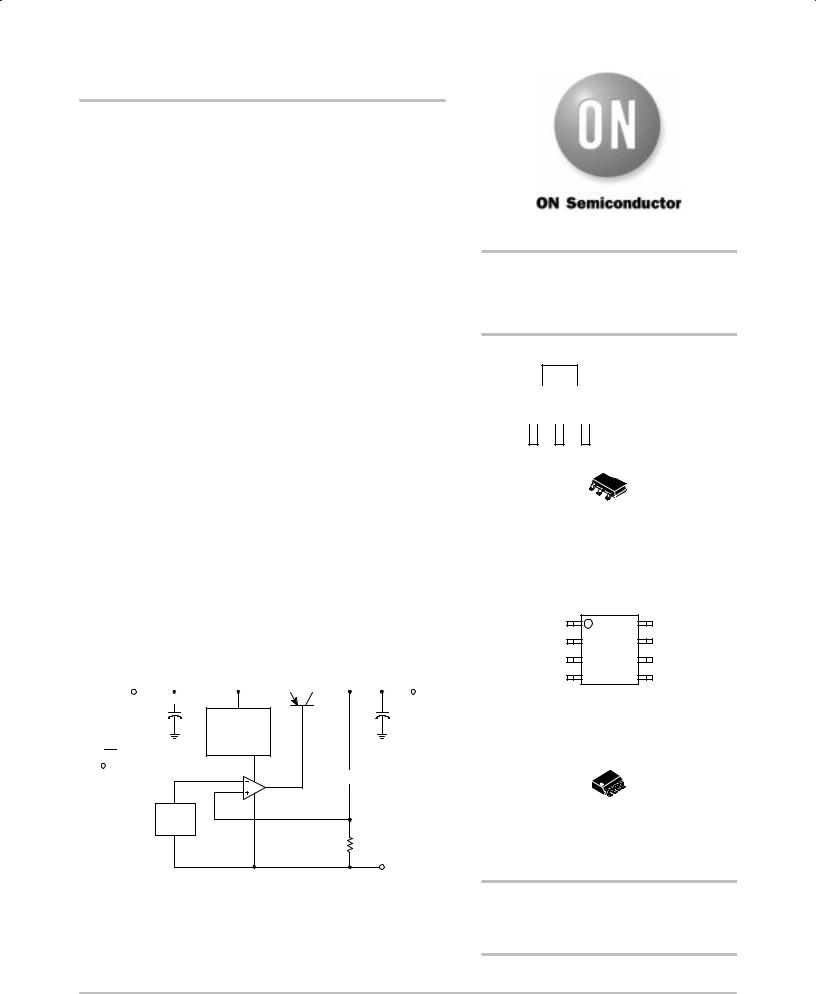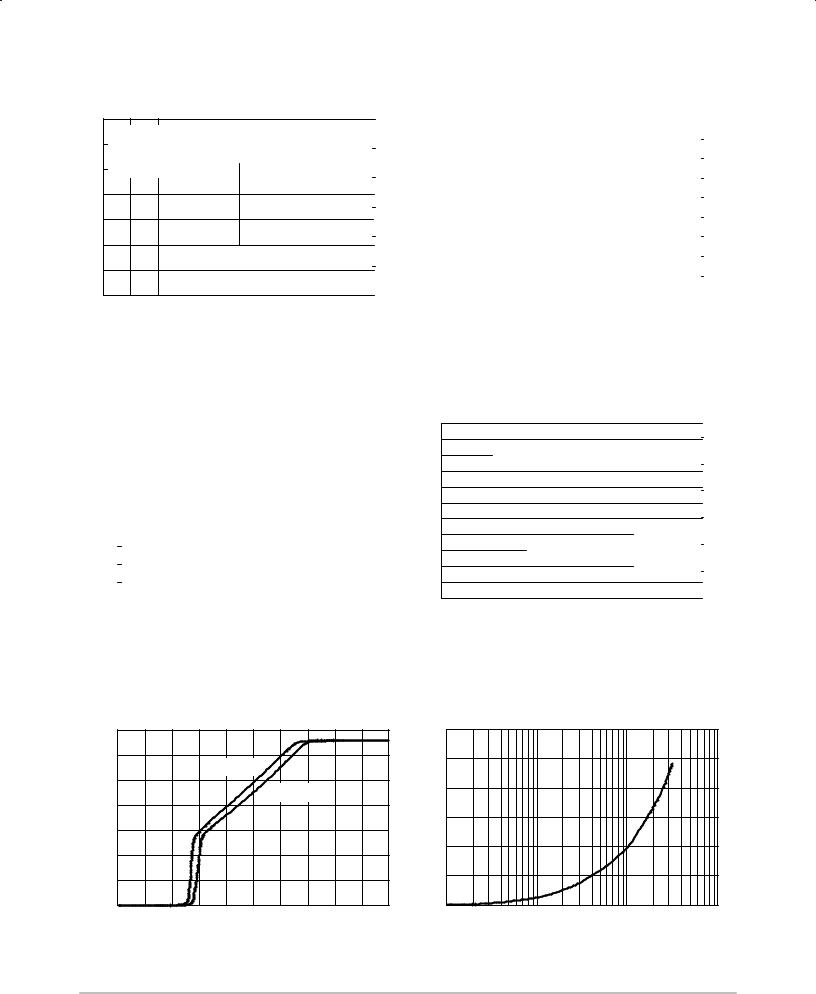MOTOROLA MC33375ST-3.3T3, MC33375D-5.0R2, MC33375ST-1.8T3, MC33375ST-2.5T3, MC33375D-3.3R2 Datasheet
...
MC33375
Advance Information
Low Dropout 300 mA Voltage Regulator with ON/OFF Control
The MC33375 series are micropower low dropout voltage regulators available in a wide variety of output voltages as well as packages, SOT±223, and SOP±8 surface mount packages. These devices feature a very low quiescent current and are capable of supplying output currents up to 300 mA. Internal current and thermal limiting protection are provided by the presence of a short circuit at the output and an internal thermal shutdown circuit.
The MC33375 has a control pin that allows a logic level signal to turn±off or turn±on the regulator output.
Due to the low input±to±output voltage differential and bias current specifications, these devices are ideally suited for battery powered computer, consumer, and industrial equipment where an extension of useful battery life is desirable.
Features:
•Low Quiescent Current (0.3 mA in OFF mode; 125 mA in ON mode)
•Low Input±to±Output Voltage Differential of 25 mV at IO = 10 mA, and 260 mV at IO = 300 mA
•Extremely Tight Line and Load Regulation
•Stable with Output Capacitance of only 0.33 mF for 2.5 V Output Voltage
•Internal Current and Thermal Limiting
•Logic Level ON/OFF Control
Simplified Block Diagram
Vin |
|
Vout |
|||
|
|
|
|
|
|
On/Off
|
|
|
|
|
|
On/Off |
|
1.23 V |
|
|
Block |
|
V. Ref. |
|
|
|
|
|
|
Thermal &
Anti±sat
Protection
Rint 
54 K
Gnd
This device contains 41 active transistors
This document contains information on a new product. Specifications and information herein are subject to change without notice.
http://onsemi.com
LOW DROPOUT
MICROPOWER VOLTAGE
REGULATOR
Gnd
4
AYW |
A = Manufacturing Code |
|
YW = Date |
||
375xx |
||
xx = Version |
||
|
1 |
2 |
3 |
Vin ON/OFF Vout
|
4 |
|
|
|
1 |
|
|
|
3 |
|
|
|
PLASTIC |
|
|
|
ST SUFFIX |
|
|
|
CASE 318E |
|
|
1 |
|
8 |
|
Input |
|
Output |
|
2 |
|
7 |
|
Gnd |
ALYW |
Gnd |
|
3 |
375xx |
6 |
|
Gnd |
Gnd |
||
|
|||
4 |
|
5 |
|
ON/OFF |
|
N/C |
Pins 4 and 5 Not Connected
AL = Manufacturing Code YW = Date
xx = Version
8 
1
PLASTIC
D SUFFIX
CASE 751
ORDERING INFORMATION
See detailed ordering and shipping information in the package dimensions section on page 10 of this data sheet.
Semiconductor Components Industries, LLC, 2000 |
1 |
Publication Order Number: |
March, 2000 ± Rev. 4 |
|
MC33375/D |

MC33375
ELECTRICAL CHARACTERISTICS (CL = 1.0μF, TA = 25°C, for min/max values TJ = ±40°C to +125°C, Note 1)
|
Characteristic |
Symbol |
Min |
Typ |
Max |
Unit |
|||
|
|
|
|
|
|
|
|||
Output Voltage |
IO = 0 mA to 250 mA |
VO |
|
|
|
Vdc |
|||
1.8 V Suffix |
TA = 25°C, Vin = [VO + 1] V |
|
1.782 |
1.80 |
1.818 |
|
|||
2.5 V Suffix |
|
|
|
|
|
2.475 |
2.50 |
2.525 |
|
3.0 V Suffix |
|
|
|
|
|
2.970 |
3.00 |
3.030 |
|
3.3 V Suffix |
|
|
|
|
|
3.267 |
3.30 |
3.333 |
|
5.0 V Suffix |
|
|
|
|
|
4.950 |
5.00 |
5.05 |
|
1.8 V Suffix |
Vin = [VO + 1] V, 0 < IO < 100 mA |
|
1.764 |
Ð |
1.836 |
|
|||
2.5 V Suffix |
2% Tolerance from TJ = ±40 to +125°C |
|
2.450 |
Ð |
2.550 |
|
|||
3.0 V Suffix |
|
|
|
|
|
2.940 |
Ð |
3.060 |
|
3.3 V Suffix |
|
|
|
|
|
3.234 |
Ð |
3.366 |
|
5.0 V Suffix |
|
|
|
|
|
4.900 |
Ð |
5.100 |
|
|
|
|
|
|
|
|
|||
Line Regulation |
Vin = [VO + 1] V to 12 V, IO = 250 mA, |
Regline |
± |
2.0 |
10 |
mV |
|||
|
All Suffixes TA = 25°C |
|
|
|
|
|
|||
Load Regulation |
Vin = [VO + 1] V, IO = 0 mA to 250 mA, |
Regload |
± |
5.0 |
25 |
mV |
|||
|
All Suffixes TA = 25°C |
|
|
|
|
|
|||
Dropout Voltage |
TJ = ±40°C to +125°C |
Vin ± VO |
|
|
|
mV |
|||
IO = 10 mA |
|
Ð |
25 |
100 |
|
||||
IO = 100 mA |
|
|
|
|
|
Ð |
115 |
200 |
|
IO = 250 mA |
|
|
|
|
|
Ð |
220 |
400 |
|
IO = 300 mA |
|
|
|
|
|
Ð |
260 |
500 |
|
Ripple Rejection (120 Hz) Vin(peak±peak) = [VO + 1.5] V to [VO + 5.5] V |
Ð |
65 |
75 |
Ð |
dB |
||||
Output Noise Voltage |
|
|
|
Vn |
Ð |
160 |
Ð |
mVrms |
|
CL = 1 mF |
IO = 50 mA (10 Hz to 100 kHz) |
|
|
||||||
CL = 200 mF |
|
|
|
|
|
Ð |
46 |
Ð |
|
CURRENT PARAMETERS |
|
|
|
|
|
|
|
|
|
|
|
|
|
|
|
|
|
|
|
Quiescent Current |
Vin = [VO + 1] V, IO = 0 mA |
IQ |
Ð |
125 |
200 |
mA |
|||
On Mode |
|
|
|||||||
Off Mode |
|
|
|
|
|
Ð |
0.3 |
4.0 |
|
On Mode SAT |
Vin = [VO ± 0.5] V, IO = 0 mA, Note 2 |
|
Ð |
1100 |
1500 |
|
|||
Current Limit |
Vin = [VO + 1] V, VO shorted |
ILIMIT |
Ð |
450 |
Ð |
mA |
|||
ON/OFF INPUTS |
|
|
|
|
|
|
|
|
|
|
|
|
|
|
|
|
|
|
|
On/Off Input Voltage |
|
|
± 2% |
VCTRL |
|
|
|
V |
|
Logic ª1º (Regulator On) V |
= V |
O |
|
2.4 |
Ð |
Ð |
|
||
|
out |
|
|
|
|
|
|
|
|
Logic ª0º (Regulator Off) V |
< 0.03V |
|
Ð |
Ð |
0.5 |
|
|||
|
out |
|
|
|
|
|
|
|
|
Logic ª0º (Regulator Off) V |
< 0.05V (1.8 V Option) |
|
Ð |
Ð |
0.3 |
|
|||
|
out |
|
|
|
|
|
|
|
|
THERMAL SHUTDOWN |
|
|
|
|
|
|
|
|
|
|
|
|
|
|
|
|
|
|
|
Thermal Shutdown |
|
|
|
|
Ð |
Ð |
150 |
Ð |
°C |
|
|
|
|
|
|
|
|
|
|
NOTE: 1. Low duty pulse techniques are used during test to maintain junction temperature as close to ambient as possible.
2. Quiescent Current is measured where the PNP pass transistor is in saturation. Vin = [VO ± 0.5] V guarantees this condition.
http://onsemi.com
2

MC33375
DEFINITIONS
Load Regulation ± The change in output voltage for a change in load current at constant chip temperature.
Dropout Voltage ± The input/output differential at which the regulator output no longer maintains regulation against further reductions in input voltage. Measured when the output drops 100 mV below its nominal value (which is measured at 1.0 V differential), dropout voltage is affected by junction temperature, load current and minimum input supply requirements.
Output Noise Voltage ± The RMS AC voltage at the output with a constant load and no input ripple, measured over a specified frequency range.
Maximum Power Dissipation ± The maximum total dissipation for which the regulator will operate within specifications.
Quiescent Current ± Current which is used to operate the regulator chip and is not delivered to the load.
Line Regulation ± The change in output voltage for a change in the input voltage. The measurement is made under conditions of low dissipation or by using pulse techniques such that the average chip temperature is not significantly affected.
Maximum Package Power Dissipation ± The maximum package power dissipation is the power dissipation level at which the junction temperature reaches its maximum value i.e. 150°C. The junction temperature is rising while the
difference between the input power (VCC X ICC) and the output power (Vout X Iout) is increasing.
Depending on ambient temperature, it is possible to calculate the maximum power dissipation and so the maximum current as following:
T ± T Pd + J A RqJA
The maximum operating junction temperature TJ is specified at 150°C, if TA = 25°C, then PD can be found. By neglecting the quiescent current, the maximum power dissipation can be expressed as:
I |
out |
+ |
PD |
|
|
VCC ± Vout |
|||||
|
|
||||
|
|
|
|||
The thermal resistance of the whole circuit can be evaluated by deliberately activating the thermal shutdown of the circuit (by increasing the output current or raising the input voltage for example).
Then you can calculate the power dissipation by subtracting the output power from the input power. All variables are then well known: power dissipation, thermal shutdown temperature (150°C for MC33375) and ambient temperature.
RqJA |
+ |
TJ ± TA |
|
|
PD |
||||
|
|
|||
http://onsemi.com
3

MC33375
Figure 1. Line Transient Response |
Figure 2. Line Transient Response |
Vin , INPUT VOLTAGE (V)
7
TA = 25° C
6CL = 0.47 mF IL = 10 mA
5 Vout = 3.3 V
4
3
2
1
0
0 20 40
|
|
|
|
|
|
|
|
|
|
|
|
|
|
|
|
|
200 |
|
|
7 |
|
|
|
|
|
|
|
|
|
|
|
|
|
|
|
|
|
|
|
|
|
|
|
|
70 |
|
|
|
|
|
|
|
|
|
|
|
|
|
|
|
|
|
|
150 |
OUTPUT |
|
6 |
|
|
|
|
|
|
|
|
|
|
|
|
|
|
|
|
|
|
|
|
|
|
|
|
|
60 |
|
|
|
|
|
Vin |
|
|
|
|
|
|
|
|
|
|
(V) |
|
|
|
|
|
|
|
|
|
|
|
|
|
|
|
|
|
|
|
|
|
|
|
|
|
50 |
||||
|
|
|
|
|
|
|
|
|
|
|
|
|
|
|
5 |
|
|
|
|
|
|
|
|
|
|
|
|
|
|
|
|
|
|
|
|
|
|
|
|
|
||||||
|
|
|
|
|
|
|
|
|
|
|
|
|
|
|
|
|
|
|
|
|
|
|
|
|
|
|
|
|
|
|
|
|
|
|
|
|
|
|
|
|
|
|
||||
|
|
|
|
|
|
|
|
|
|
|
|
|
|
|
|
|
|
|
|
|
|
|
|
|
|
|
|
|
|
|
|
|
|
|
|
|
|
|
|
|
|
|
||||
|
|
|
|
|
|
|
|
|
|
|
|
|
|
|
|
|
100 |
VOLTAGE |
VOLTAGE |
4 |
|
|
|
|
|
|
|
|
|
|
|
|
|
|
|
|
|
|
|
|
|
|
|
|
|
40 |
|
|
|
|
|
|
|
|
|
|
|
|
|
|
|
|
|
|
|
|
|
|
|
|
|
|
|
|
|
|
|
|
|
|
|
|
|
|
|
|
|
||||||
|
|
|
|
|
|
|
|
|
|
|
|
|
|
|
|
|
|
|
|
|
|
|
|
|
|
|
|
|
|
|
|
|
|
|
|
|
|
|
|
|
|
|||||
|
|
|
|
|
|
|
|
|
|
|
|
|
|
|
|
|
50 |
|
|
|
|
|
|
|
|
|
|
|
|
|
|
|
|
|
|
|
|
|
|
|
|
|
30 |
|||
|
|
|
|
|
|
|
|
|
|
|
|
|
|
|
|
|
|
|
|
|
|
|
|
|
|
|
|
|
|
|
|
|
|
|
|
|
|
|
|
|
|
|
|
|||
|
|
|
|
|
|
|
|
|
|
|
|
|
|
|
|
|
0 |
CHANGE |
INPUT, |
3 |
|
|
|
|
|
|
|
|
|
|
|
|
|
|
|
|
|
|
|
|
|
|
|
|
|
20 |
|
|
|
|
|
|
|
|
|
|
|
|
|
|
|
|
|
|
|
|
|
|
|
|
|
|
|
|
|
|
|
|
|
|
|
|
|
|
|
|
|
||||||
|
|
|
|
|
Vout |
|
|
|
|
|
|
|
|
|
2 |
|
|
|
|
|
|
|
|
|
|
|
|
|
|
|
|
|
|
|
|
|
|
|
|
|
0 |
|||||
|
|
|
|
|
|
|
|
|
|
|
|
|
|
in |
|
|
|
|
|
|
|
|
|
|
|
|
|
|
|
|
|
|
|
|
|
|
|
|
|
|
||||||
|
|
|
|
|
|
|
|
|
|
|
|
|
|
|
|
|
|
|
|
|
|
|
|
|
|
|
|
|
|
|
|
|
|
|
|
|
|
|
|
|
|
|
|
|
10 |
|
|
|
|
|
|
|
|
|
|
|
|
|
|
|
|
|
|
±50 |
(mV) |
V |
1 |
|
|
|
|
|
|
|
|
|
|
|
|
|
|
|
|
|
|
|
|
|
|
|
|
±10 |
|
|
|
|
|
|
|
|
|
|
|
|
|
|
|
|
|
|
|
|
0 |
|
|
|
|
|
|
|
|
|
|
|
|
|
|
|
|
|
|
|
|
|
|
|
|
|
|
|
|
|
|
|
|
|
|
|
|
|
|
|
|
|
|
|
|
±100 |
|
|
|
|
|
|
|
|
|
|
|
|
|
|
|
|
|
|
|
|
|
|
|
|
|
|
±20 |
||
|
|
|
|
|
|
|
|
|
|
|
|
|
|
|
|
|
|
|
|
|
|
|
|
|
|
|
|
|
|
|
|
|
|
|
|
|
|
|
|
|
|
|
|
|||
60 |
80 |
100 |
120 |
140 |
160 |
180 |
200 |
|
|
0 |
50 |
|
|
100 |
|
|
|
|
150 |
|
|
|
200 |
|||||||||||||||||||||||
|
|
|
|
TIME (mS) |
|
|
|
|
|
|
|
|
|
|
|
|
|
|
|
|
|
|
|
|
TIME (mS) |
|
|
|
|
|
|
|
|
|||||||||||||
(mV) CHANGE VOLTAGE OUTPUT
LOAD CURRENT (mA)
Figure 3. Load Transient Response
300 |
|
|
|
|
|
|
|
|
|
|
|
|
|
|
|
|
|
1.0 |
|
|
|
|
|
|
|
|
|
|
|
|
|
|
|
|
|
|
|
0.8 |
|
|
|
200 |
|
|
|
|
|
|
|
|
|
|
|
|
|
|
|
|
|
|
|
|
|
|
|
|
|
|
|
|
|
|
|
|
|
|
|
|
|
0.4 |
|
OUTPUT |
|
0 |
|
|
|
|
|
LOAD CURRENT |
|
|
|
|
|
|
|
|
|
|||||
100 |
|
|
|
|
|
|
|
|
|
|
|
|
|
0.6 |
|
|
||||
|
|
|
|
|
|
|
|
|
|
|
|
|
|
|
|
|
|
|
|
|
|
|
|
|
|
|
|
|
|
|
|
|
|
|
|
|
|
|
|
|
|
|
|
|
|
|
|
|
|
|
|
|
|
|
|
|
|
|
|
|
|
|
±100 |
|
|
|
|
|
|
|
|
|
|
|
|
|
|
|
|
|
0.2 |
|
VOLTAGE |
|
|
|
|
|
|
|
|
|
|
|
|
|
|
|
|
|
|
|
||
|
|
|
|
|
|
|
|
|
|
|
|
|
|
|
|
|
|
|
|
|
±200 |
|
|
|
|
|
|
|
|
|
|
|
|
|
|
|
|
|
|
0 |
|
|
|
|
|
|
|
|
|
|
|
|
|
|
|
|
|
|
±0.2 |
|
||
±300 |
|
|
|
|
|
|
|
|
|
|
|
|
|
|
|
|
|
|
CHANGE |
|
|
|
|
|
|
|
Vout CHANGE |
|
|
|
|
|
|
|
|
|
|||||
|
|
Vout = 3.3 V |
|
|
|
|
|
|
|
|
|
|
|
±0.6 |
|
|||||
±400 |
|
CL = 1.0 mF |
|
|
|
|
|
|
|
|
|
|
|
|
|
|
±0.4 |
|
|
|
|
|
|
|
|
|
|
|
|
|
|
|
|
|
|
|
|
|
|||
±500 |
|
TA = 25° C |
|
|
|
|
|
|
|
|
|
|
|
|
|
|
|
|
(V) |
|
|
|
|
|
|
|
|
|
|
|
|
|
|
|
|
±0.8 |
|
||||
±600 |
|
Vin = 4.3 V |
|
|
|
|
|
|
|
|
|
|
|
|
|
|
|
|||
|
|
|
|
|
|
|
|
|
|
|
|
|
|
|
|
|
||||
|
|
|
|
|
|
|
|
|
|
|
|
|
|
|
±1.0 |
|
|
|||
±700 |
|
|
|
|
|
|
|
|
|
|
|
|
|
|
|
|
|
|
|
|
|
|
|
|
|
|
|
|
|
|
|
|
|
|
|
|
|
|
|
||
|
50 |
100 |
150 |
200 |
250 |
300 |
350 |
400 |
|
|||||||||||
0 |
|
|||||||||||||||||||
TIME (mS)
|
350 |
|
|
250 |
|
(mA) |
150 |
|
50 |
||
|
||
CURRENT |
±50 |
|
±150 |
||
|
||
|
±250 |
|
LOAD |
±350 |
|
±450 |
||
|
±550 |
±650
±750
0
Figure 4. Load Transient Response
|
|
|
|
|
|
|
|
|
|
|
|
|
|
0.14 |
|
|
|
|
|
|
|
|
|
|
|
|
|
|
|
|
OUTPUT |
|
|
LOAD CURRENT |
|
|
|
|
|
|
|
0.09 |
|||||
|
|
|
|
|
|
|
|
|
VOLTAGE |
||||||
|
|
|
|
|
|
|
|
|
|
|
|
|
|
||
|
|
|
|
|
|
|
|
|
|
|
|
|
|
0.04 |
|
|
|
|
|
|
|
|
|
|
|
|
|
|
|
|
|
|
|
|
|
|
|
|
|
|
|
|
|
|
|
±0.01 |
|
|
|
|
|
|
|
|
|
|
|
|
|
|
|
|
CHANGE |
|
|
|
|
|
|
|
|
|
|
TA = 25° C |
|
|
|
||
|
|
|
|
|
|
|
|
|
|
CL = 33.0 mF |
|
|
|
||
|
|
|
|
Vout CHANGE |
|
|
|
±0.06 |
|
||||||
|
|
|
|
|
|
|
|
|
|
Vout = 3.3 V |
|
|
|
|
|
|
|
|
|
|
|
|
|
|
|
Vin = 4.3 V |
|
|
±0.11 |
(V) |
|
|
|
|
|
|
|
|
|
|
|
|
|
||||
|
|
|
|
|
|
|
|
|
|
|
|
|
|
±0.16 |
|
50 |
100 |
150 |
|
200 |
250 |
300 |
|
||||||||
|
|
|
|||||||||||||
TIME (mS)
Figure 5. Output Voltage versus Input Voltage |
Figure 6. Dropout Voltage versus Output Current |
|
3.5 |
|
|
|
|
|
|
|
|
|
|
300 |
|
3.0 |
|
|
|
IL = 1 mA |
|
|
|
|
(mV) |
250 |
|
(V) |
|
|
|
|
|
|
|
|
|
|||
2.5 |
|
|
|
|
|
|
|
|
|
200 |
||
VOLTAGE |
|
|
|
|
|
IL = 250 mA |
|
|
VOLTAGE |
|||
|
|
|
|
|
|
|
|
|||||
|
|
|
|
|
|
|
|
|
||||
2.0 |
|
|
|
|
|
|
|
|
|
150 |
||
|
|
|
|
|
|
|
|
|
|
|||
|
|
|
|
|
|
|
|
|
|
|
||
OUTPUT |
1.5 |
|
|
|
|
|
|
|
|
|
DROPOUT |
|
1.0 |
|
|
|
|
|
|
|
|
|
100 |
||
|
|
|
|
|
|
|
|
|
|
|||
|
|
|
|
|
|
|
|
|
|
50 |
||
|
0.5 |
|
|
|
|
|
|
|
|
|
|
|
|
|
|
|
|
|
|
|
|
|
|
|
|
|
0 |
0.5 |
|
1.5 |
2.0 |
|
3.0 |
3.5 |
4.0 |
|
5.0 |
0 |
|
0 |
1.0 |
2.5 |
4.5 |
|
|||||||
|
|
|
|
|
INPUT VOLTAGE (V) |
|
|
|
|
|
||
1 |
10 |
100 |
1000 |
IO, OUTPUT CURRENT (mA)
http://onsemi.com
4
